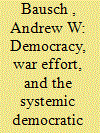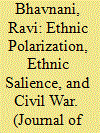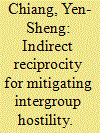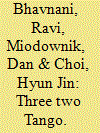|
|
|
Sort Order |
|
|
|
Items / Page
|
|
|
|
|
|
|
| Srl | Item |
| 1 |
ID:
140077


|
|
|
|
|
| Summary/Abstract |
This article uses an agent-based model and Selectorate Theory to explore the micro-foundations of the systemic democratic peace. Leaders engage in an international bargaining game that can escalate to conflict. Upon resolving the dispute, leaders distribute winnings to domestic constituencies and stand for reselection. The model’s assumptions about selectorate size in a democracy versus an autocracy make democratic leaders more accountable than autocrats and endogenously generates the dyadic democratic peace. The model shows no evidence of an autocratic peace, as mixed dyads are less likely to go to war than autocratic dyads. I further show that democratic leaders invest more resources in wars than predicted by the Nash equilibrium and also more than autocrats. This overinvestment by democratic leaders results in democracies winning more wars than autocrats. This model thus reinforces previous findings that democratic leaders respond to domestic reselection incentives by using more resources in conflict to gain a war-fighting advantage and help ensure victory. Finally, consistent with empirical results, I show that increasing the percentage of democracies in the system does not have a linear effect on the amount of conflict in the system. Below a certain threshold, increasing democracy has no effect on conflict, while after this threshold conflict decreases.
|
|
|
|
|
|
|
|
|
|
|
|
|
|
|
|
| 2 |
ID:
086001


|
|
|
|
|
| Publication |
2009.
|
| Summary/Abstract |
This article examines how the relationship between ethnic polarization and civil war could be moderated by different degrees of ethnic salience. Using an agent-based computational model, we analyze the polarization-conflict relationship when ethnic salience is ``fixed''-high for every member of two nominally rival ethnic groups- and ``variable''-permitted to vary across individuals as a function of relative income. We find that (1) when salience is fixed, conflict onset is twice as high at low levels of polarization compared to when salience is permitted to vary, with the difference decreasing at high levels of polarization; (2) the relationship between conflict onset and the range over which we calculate variable salience is positive and robust for low and moderate levels of polarization; (3) the relationship between polarization and conflict onset is robust even under minority domination, if one holds salience fixed; and (4) holding ethnic salience fixed effectively amplifies the negative effect of polarization on economic performance.
|
|
|
|
|
|
|
|
|
|
|
|
|
|
|
|
| 3 |
ID:
096743


|
|
|
|
|
| Publication |
2010.
|
| Summary/Abstract |
Electric utilities and regulators face difficult challenges evaluating new energy efficiency and smart grid programs prompted, in large part, by recent state and federal mandates and financial incentives. It is increasingly difficult to separate electricity use impacts of individual utility programs from the impacts of increasingly stringent appliance and building efficiency standards, increasing electricity prices, appliance manufacturer efficiency improvements, energy program interactions and other factors. This study reviews traditional approaches used to evaluate electric utility energy efficiency and smart-grid programs and presents an agent-based end-use modeling approach that resolves many of the shortcomings of traditional approaches. Data for a representative sample of utility customers in a Midwestern US utility are used to evaluate energy efficiency and smart grid program targets over a fifteen-year horizon. Model analysis indicates that a combination of the two least stringent efficiency and smart grid program scenarios provides peak hour reductions one-third greater than the most stringent smart grid program suggesting that reductions in peak demand requirements are more feasible when both efficiency and smart grid programs are considered together. Suggestions on transitioning from traditional end-use models to agent-based end-use models are provided.
|
|
|
|
|
|
|
|
|
|
|
|
|
|
|
|
| 4 |
ID:
177024


|
|
|
|
|
| Summary/Abstract |
Social scientists have proposed myriad solutions for mitigating intergroup conflicts. While the literature, such as studies on intergroup contact theory, focuses on intergroup relations, we argue that it is important not to ignore intragroup relations that may benefit or undermine the improvement of intergroup relations at the same time. In this paper, we investigate a typology of eight mechanisms for the behavior of intergroup and intragroup relations. Specifically, we focused on interactions in a triad consisting of an actor paired up with two alters—one ingroup and one outgroup. The triadic network enabled us to theorize and test how intergroup and intragroup relations coevolve. We conducted a vignette experiment to test the intergroup relationship between mainland Chinese and Taiwanese. We found strong evidence for one mechanism for improving intergroup hostility: indirect reciprocity—people rewarded the outgroup for behaving friendly to their ingroup peers. Using agent-based simulation, we predicted that the triadic effect found in the one-shot experiment can continuously improve and stabilize intergroup relations over time.
|
|
|
|
|
|
|
|
|
|
|
|
|
|
|
|
| 5 |
ID:
101860


|
|
|
|
|
| Publication |
2011.
|
| Summary/Abstract |
This article extends the formal logic of Stathis Kalyvas' theory of selective violence to account for three political actors with asymmetric capabilities. In contrast to Kalyvas' theory, the authors' computer simulation suggests that (1) selective violence by the stronger actor will be concentrated in areas where weaker actors exercise control; (2) the relative level of selective violence used by weaker actors will be lower because of a reduced capacity to induce civilian collaboration; and (3) areas of parity among the three actors will exhibit low levels of selective violence perpetrated primarily by the strongest actor. Results from a logistic regression, using empirical data on Israel and two rival Palestinian factions from 2006 to 2008, are consistent with these predictions: Israel was more likely to use selective violence in areas largely controlled by Palestinian factions; zones of incomplete Israeli control were not prone to selective violence; and zones of mixed control witnessed moderate levels of selective violence, mainly by Israel. Nonetheless, Palestinian violence remained consistent with Kalyvas' predictions.
|
|
|
|
|
|
|
|
|
|
|
|
|
|
|
|
|
|
|
|
|